10 Essential Self Massage Techniques for Relief

Written by
Tran Quang
Reviewed by
Prof. Benjamin Murphy, Ph.D.Self massage techniques require only hands or affordable tools like tennis balls
Ten essential methods target specific areas: head, neck, back, and limbs
Consistent 5-10 minute sessions yield better results than occasional deep pressure
Proper body positioning and gradual pressure increase ensure safety during application
Regular practice reduces muscle tension, improves mobility, and decreases headache frequency
Immediate start possible with household items, no professional equipment or training needed
Article Navigation
Self-massage techniques for instant muscle relief. You can perform them with your hands or simple tools, and they can fit into any schedule at home or at work. They will save you money over visits to a professional therapist. I depend on them myself every day for relief from my own muscle tension.
Experience meaningful pain relief by practicing regularly. As you release tension spots, stress begins to dissolve. Accessibility is a significant difference with these techniques. Anyone can start today, without special training. I've seen clients change their wellness with just five minutes a day spent practicing.
The wellness trends today encourage these practical techniques. Next, you will learn ten valuable strategies that you can immediately apply. They will help with common areas, such as your back and neck. Each method will remedy a specific discomfort. I have mastered the strategies that I have learned during years of teaching my clients.
Tools for Effective Self Massage
Your hands are the most versatile self-massage tools you don't have to buy, have no equipment to supervise, and can perform anywhere. Beginning students usually find them good for sensitive areas (the temples, for instance, and the muscles of the neck). I require my students to start here and later develop other techniques. You have a fine sense of the proper pressure, controlled automatically by your fingertips and the palms of your hands.
The medium pressure of tennis balls provides the perfect way to target shoulders and backs. Roll them against the wall to target muscle knots. Foam rollers provide a deeper intensity of pressure and are better suited for larger muscle groups, such as the thighs. I use my foam roller after workouts to release tightness in my leg muscles. Scroll down for tools to help you find tennis balls and foam rollers at places like sporting goods stores.
Safety indicates starting soft and gradually working your way to deeper pressure. Never go too deep into pressure. This takes weeks of tolerance building. Specialty stores, including many online, sell high-quality tools for stubborn areas, such as massage balls and theracanes. I always test any new tools on myself before recommending them.
Accessibility defines self-massage. Most tools cost less than a coffee. You can get them anytime. I keep tennis balls in my car and office. They make any space an instant examination station. Start with the basics. As you improve your technique, improve your equipment.
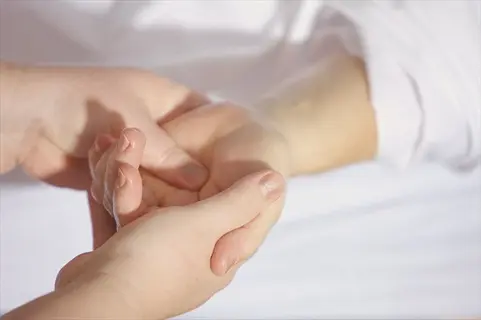
Hands
- Your hands serve as versatile massage tools requiring no equipment, making them ideal for sensitive areas like the head, neck, and feet where gentle pressure control prevents discomfort.
- Fingertips effectively detect muscle tension while palms provide broad compression relief across larger surface areas for generalized relaxation during sessions.
- Available anytime without preparation, they offer quick tension relief through precise knuckle pressure on thicker muscle groups safely.
- Applying light massage oil creates smoother gliding motions across skin surfaces enhancing comfort and effectiveness during treatment.
- Thumbs specifically target stubborn trigger points along spinal columns and shoulder blade regions needing focused attention.
- Regular hand stretching maintains flexibility for sustained pressure application during extended self-massage routines at home.
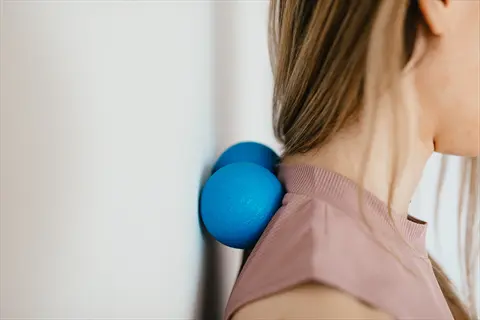
Tennis Ball
- Tennis balls deliver medium pressure perfectly suited for shoulders, back muscles, and foot arches needing targeted knot relief.
- Their compact size enables precise targeting when leaned against walls or floors for isolated tension release.
- Slow rolling movements help locate tender spots before pausing to apply sustained pressure for maximum effectiveness.
- As safer alternatives to harder balls like golf versions, they prevent bruising especially for beginners.
- Body weight adjustments allow customizable intensity during sessions while replacing worn surfaces maintains consistent texture.
- Ideal for travel due to lightweight portability and compatibility with various body positions during use.
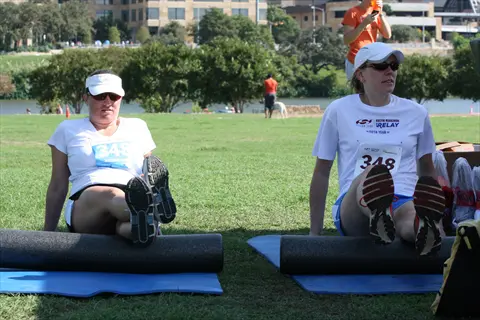
Foam Roller
- Cylindrical foam rollers efficiently treat large muscle groups including legs, back, and glutes through comprehensive coverage.
- Available in gentle densities for newcomers and firm options for advanced users seeking deeper penetration.
- Slow rolling along muscle lengths breaks fascial adhesions while pausing on tender spots releases chronic tension.
- Supports full body weight for intensive myofascial release techniques that improve flexibility over time.
- Textured surfaces increase blood flow stimulation while ribbed designs enhance grip during dynamic movements.
- Regular cleaning maintains hygiene and prevents skin irritation during repeated use on bare skin.
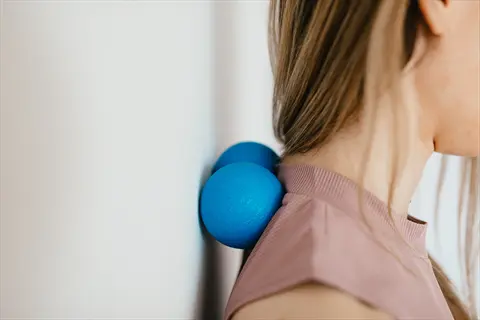
Massage Balls
- Compact massage balls penetrate deep trigger points in hips, glutes, and shoulder blades with concentrated pressure.
- Portable sizes fit easily in bags making them perfect for office desks or travel wellness kits.
- Varied densities include soft silicone for delicate neck areas and firm rubber for resilient feet.
- Wall-assisted positioning allows controlled body angles targeting hard-to-reach spots without straining.
- Grooved surfaces increase therapeutic stimulation while avoiding excessive pressure on sensitive tissues.
- Combination units with vibration functions provide enhanced muscle relaxation through dual-action technology.
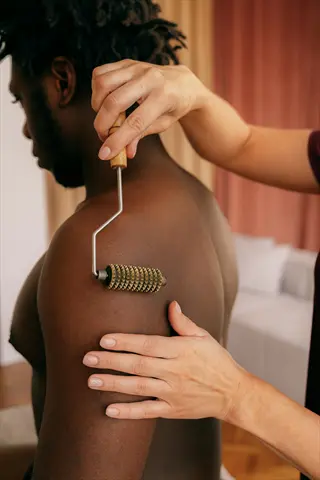
Theracane
- Theracane's S-shaped design independently accesses difficult upper back regions unreachable by hands alone.
- Knobbed ends deliver pinpoint pressure to stubborn trapezius and rhomboid trigger points between shoulders.
- Self-gripping handles enable controlled force application without wrist strain during extended sessions.
- Adjustable angles accommodate diverse body types while ergonomic grips enhance user comfort substantially.
- Durable construction withstands long-term use for chronic tension sufferers needing regular maintenance.
- Regular inspections ensure structural integrity and prevent potential breakage during deep pressure applications.

Vibrating Devices
- Oscillating mechanisms in vibrating devices enhance muscle relaxation beyond manual pressure limitations effectively.
- Variable speed controls adjust percussion intensity from gentle vibrations to deep tissue penetration gradually.
- Ergonomic shapes specifically target problem zones like neck stiffness or plantar fascia discomfort.
- Rechargeable batteries provide cord-free convenience for home, office, or travel usage scenarios.
- Heat functions increase localized blood circulation to stiff tissues accelerating recovery processes significantly.
- Interchangeable heads customize treatments for different body regions ensuring versatile therapeutic applications.
10 Self Massage Techniques Explained
To begin the head massage, sit comfortably with your elbows resting on a flat surface, such as a table or a chair. Place your thumbs on your cheekbones, near your ears, and your fingertips on both temples. Begin with light circular movements, applying gentle pressure for three minutes, moving around the hairline. This can help relieve tension headaches caused by stress. Concentrate on the sore spots on the head and hold for twenty seconds.
To alleviate shoulder stress, firmly grasp the trapezius muscle. Squeeze as you shrug upward, then release downward. Use medium-pressure circular motions toward the base of your neck. Repeat ten times per side. Finish with cross-body arm stretches, holding each for 20 seconds.
For upper back relief, use a tennis ball against a wall for support. Slowly lean against it, moving up, down, and sideways. Apply firm pressure for thirty seconds to tender spots along your spine. Avoid hard bone contact. Change position to thoroughly cover the shoulder blades and rhomboid muscles.
To alleviate foot soreness, complete a foot massage using a tennis ball under your bare foot. While keeping your muscles moderately tight, roll your foot from heel to toe, then go to the arches and use a circular motion to relieve the inflammation in the plantar fascia. Use your thumbs to massage the top of the foot between the bones, then finish the massage by gently pulling each toe.

Head Massage
- Sit comfortably with elbows supported on a table to relieve neck strain during the entire massage process for optimal comfort
- Place thumbs high on cheekbones near ears with fingertips positioned at temples applying gentle circular pressure movements
- Continue these circular motions while moving fingers progressively along your hairline until they meet at forehead center position
- Focus additional attention on tender areas by applying sustained pressure for twenty seconds before gradually releasing tension
- Complete the massage technique by gently pulling hair sections at the roots to stimulate scalp circulation effectively
- Perform this entire sequence for three minutes to relieve tension headaches caused by daily stress or prolonged screen time
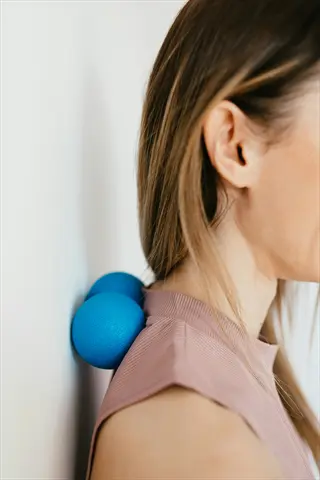
Neck Massage
- Sit upright in a stable chair with both feet flat on the floor maintaining proper spinal alignment throughout the massage
- Place two or three fingertips where neck meets shoulders applying firm downward pressure using controlled breathing patterns
- Maintain this pressure position for thirty seconds while taking deep breaths to encourage complete muscle tension release
- Slowly roll shoulders forward five times then backward five times enhancing overall mobility and range of motion
- Gradually move fingers up the neck toward skull base repeating pressure application at any identified tense spots
- Conclude by using opposite hand to gently pull head toward shoulder stretching lateral neck muscles thoroughly

Shoulder Massage
- Position your left hand firmly on top of the right shoulder while gripping the trapezius muscle area securely
- Squeeze the shoulder muscle while shrugging upward then completely release pressure during the downward motion phase
- Apply deliberate circular motions with fingers moving methodically from shoulder edge toward the neck base region
- Repeat this entire sequence ten times before systematically switching to massage the opposite shoulder area
- Gradually increase pressure intensity on identified knots while exhaling deeply to maximize tension relief benefits
- Finish the technique with cross-body arm stretches holding each position steadily for twenty seconds per side
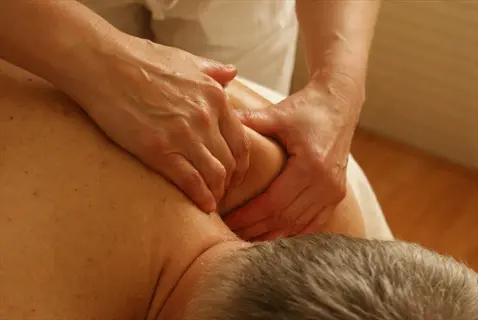
Upper Back
- Stand firmly against a stable wall while strategically placing a tennis ball between spine and shoulder blade region
- Lean body weight carefully into the ball while moving slowly in controlled up/down and side-to-side directions
- Locate specific tender spots precisely and pause applying steady therapeutic pressure for thirty seconds each
- Systematically adjust ball position to cover the entire upper back area including hard-to-reach rhomboid muscles
- Consciously avoid direct spine pressure by focusing exclusively on muscular regions beside the vertebral column
- Repeat this entire procedure after repositioning the ball to the opposite side ensuring symmetrical tension release
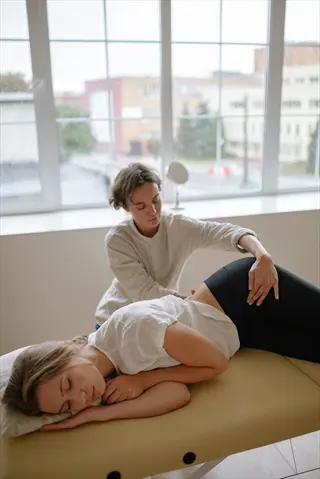
Lower Back
- Lie comfortably on your back with knees carefully bent while positioning a tennis ball under lumbar area muscles
- Place the ball strategically beside your spine while avoiding direct bony contact for optimal muscle targeting
- Shift body weight gently while rolling the ball in deliberate small circular motions at a controlled pace
- Pause intentionally on identified tense spots maintaining therapeutic pressure while taking five deep breaths
- Reposition the ball systematically to cover the entire lower back region extending from hips to lower ribs
- Conclude the technique by hugging knees to chest while stretching the relieved lower back muscles gently
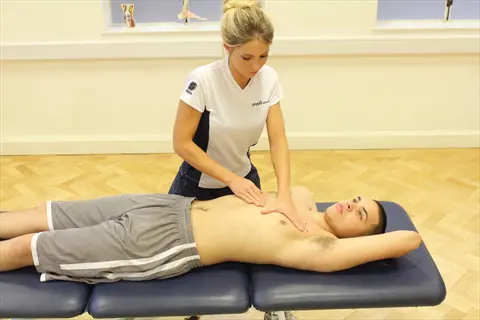
Chest Massage
- Stand or sit upright placing fingertips strategically just below collarbone on pectoral muscle origins carefully
- Apply medium pressure intensity using deliberate circular motions while moving progressively toward shoulder direction
- Enhance effectiveness by simultaneously raising your arm overhead during massage to stretch pectoral muscles fully
- Specifically target upper chest regions near armpits where tension commonly accumulates during daily activities
- For deeper penetration on stubborn knots, utilize a tennis ball pressed firmly against a stable wall surface
- Perform this massage technique consistently for two minutes per side improving both posture and breathing capacity

Arms & Hands
- Rest your forearm securely on a table surface with palm facing upward starting massage at the wrist junction area
- Use your opposite thumb to make long therapeutic strokes progressing slowly from wrist toward elbow region
- Apply focused circular pressure specifically to forearm muscles that develop tension during typing activities
- Squeeze the entire hand methodically between your palm and fingers working systematically from wrist to fingertips
- Gently stretch fingers backward while holding each digit individually for ten seconds to enhance flexibility
- Complete the massage by applying thumb pressure to palm areas relieving carpal tunnel discomfort effectively

Leg Massage
- Sit securely on the floor while positioning a foam roller horizontally under thigh muscles for support
- Slowly roll your body weight from hips toward knees maintaining complete control throughout each movement
- Rotate legs deliberately inward and outward positions targeting different muscle groups comprehensively
- Pause intentionally on identified tender areas maintaining pressure for twenty seconds allowing tension release
- Switch focus to calves while repeating rolling motions with both pointed and flexed foot positions alternately
- Conclude the technique with a seated forward fold hamstring stretch holding steadily for thirty seconds
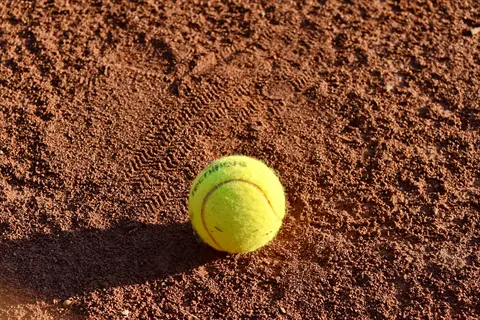
Foot Massage
- Sit comfortably in a chair while placing a tennis ball under your bare foot applying moderate controlled pressure
- Roll the ball systematically from heel to toe regions covering the entire sole surface methodically
- Pause deliberately on arch areas applying circular motions specifically for plantar fascia relief purposes
- Optionally increase pressure intensity by standing partially on the ball if tolerable and physically safe
- Massage the top foot surface using thumb strokes applied carefully between metatarsal bone structures
- Complete the technique by gently pulling each toe individually to enhance overall foot flexibility substantially
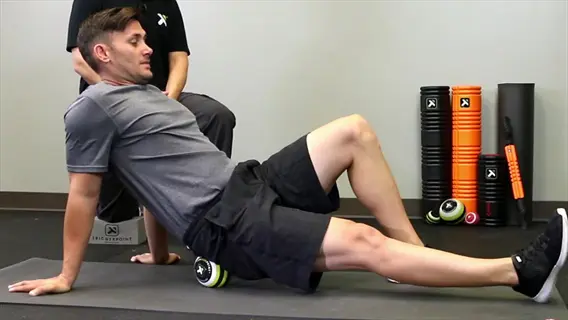
Glutes & Hips
- Sit securely on the floor with knees carefully bent while positioning a massage ball under right buttock area
- Lift your right foot completely off ground while rolling the ball in small controlled circular motions slowly
- Locate specific tender spots precisely applying sustained therapeutic pressure for thirty seconds each
- Adjust body position strategically to target the piriformis muscle which commonly causes sciatic nerve pain
- Repeat this entire sequence systematically on the left side ensuring balanced muscular tension release
- Conclude with a figure-four stretching position holding steadily for twenty seconds on each affected side
Tips for Optimal Results
ALWAYS BEGIN A WARM UP LIKE LIGHT STRETCHING OR A WARM SHOWER. THIS WILL PREPARE THE MUSCLES FOR DEEPER WORK. I LEARNED THIS EARLY IN MY PRACTICE. NOT DOING IT SERIOUSLY LESSENS THE EFFECTIVENESS. TAKE TWO MINUTES TO MOVE THE JOINTS SLIGHTLY. THIS PREPARES THE MUSCLES TO RESPOND BETTER TO THE PRESSURE.
Always begin each technique with light pressure, gradually increasing it until you reach your comfort zone. Do not strain for intensity. I teach clients to listen for signals indicating muscle release. Stop at any sign of sharp pain. Medium Pressure works best for most areas, except sensitive ones like the neck.
Limit working time on each area to two to five minutes. Overuse causes sore muscles. I take three-minute periods for the neck. Any longer work may cause excessive strain. Disperse them throughout the day. Consistency is better than long periods. Long sessions are always more difficult for sustainable relief.
Drink water before and after receiving massage therapy. Good hydration flushes metabolic waste products from tissues in the muscles. I personally drink sixteen ounces after the treatment. This helps reduce next-day stiffness. Dehydration can defeat the purpose of your massage treatment. Remember always to follow water drinking with light walking for optimal recovery results.
Preparation Techniques
- Take a warm shower or bath before massaging to help loosen tight muscles and improve overall blood circulation throughout the body
- Apply grape-seed oil or unscented lotion generously to reduce skin friction enabling smoother gliding motions during massage sessions
- Position yourself comfortably using pillows or supportive chairs to maintain proper spinal alignment and prevent additional muscle strain
- Practice deep breathing exercises for two full minutes to relax your nervous system and enhance bodily receptiveness to treatment
Pressure Management
- Begin with light fingertip pressure testing sensitivity levels before gradually increasing intensity over a one-minute adjustment period
- Identify your personal comfort threshold by noting when pressure transitions from therapeutic to uncomfortable during application
- Avoid excessive force that causes visible redness or lasting discomfort to prevent potential tissue damage during self-treatment
- Release pressure immediately if you experience sharp or radiating pain that extends beyond the immediate massage area
Duration & Frequency
- Limit sessions to twenty minutes maximum to prevent overstimulation of muscles and potential nerve irritation
- Spend two to three minutes per body area focusing additional time on larger muscle groups like back or legs
- Perform maintenance massages two or three times weekly with daily sessions only during acute pain episodes
- Allow forty-eight hours recovery between sessions using deep-pressure tools to give tissues adequate healing time
Post-Massage Care
- Drink sixteen ounces (473 milliliters) of water immediately after massaging to support natural muscle recovery processes
- Perform gentle stretching exercises holding each position steadily for twenty seconds to elongate treated muscles
- Apply cool compresses wrapped in thin towels if temporary inflammation occurs limiting application to ten-minute intervals
- Avoid strenuous physical activities for one full hour allowing your body to integrate relaxation responses properly
Tool Maintenance
- Clean foam rollers weekly using mild soap and water solutions to prevent bacterial accumulation within textured surfaces
- Inspect tennis balls monthly replacing them when surfaces become overly smooth and lose therapeutic gripping ability
- Store massage equipment in dry shaded areas preventing material degradation from direct sunlight exposure
- Disinfect vibrating devices thoroughly after each use following specific manufacturer guidelines for electrical components
Progress Tracking
- Maintain a personal journal noting discomfort levels before and after sessions using simple descriptive terms
- Record measurable mobility improvements like increased shoulder rotation range or deeper forward bending ability
- Take monthly posture photos to visually track alignment changes especially for rounded shoulders or forward head position
- Note reduced occurrence of common issues like tension headaches over consistent six-week practice periods
Benefits of Self Massage
The benefits are immediate *relief of pain* and greater ease of movement. For example, when one releases tension in the neck, headaches often disappear. Better postures come from correcting rounded shoulders. I find that when clients become accustomed to it, they tend to grow taller. These changes occur without the need for expensive consultants or equipment.
The psychological benefits occur with stress reduction during the session. Concentrated breathing with pressure reduces anxiety. Many people get a deeper sleep after an evening session. I notice clearer thinking after a massage. Your mood improves when muscle tension is unwound naturally.
The cost savings are substantial compared to those of a professional therapist. No traveling, and scheduling is never a problem. ..." Home or office appointments work into your schedule. Each year, I saved thousands of dollars utilizing these self methods. Purchase a single tennis ball rather than weekly bills.
Improve your posture and energy to gain in your daily life. For those who work at desks, there are some simple techniques for remedying the slouch. The quality of sleep improves with pre-bed routines. I instruct in office stretches of five minutes. These small things can have a profoundly positive impact on your entire life.
Physical Pain Relief
- Reduces muscle soreness and stiffness by increasing blood circulation to affected areas accelerating natural recovery processes
- Alleviates chronic tension in common problem zones like neck, shoulders, and lower back through targeted pressure application techniques
- Decreases headache frequency by releasing suboccipital muscle tension often caused by prolonged screen time or poor ergonomics
- Improves joint mobility by breaking fascial adhesions that limit movement range particularly in hips and shoulder joints
Mental Wellness Enhancement
- Lowers stress hormone cortisol levels while stimulating endorphin production for natural mood elevation and relaxation
- Decreases anxiety symptoms through parasympathetic nervous system activation promoting deep states of calm and mental clarity
- Enhances sleep quality by reducing physical discomfort and mental chatter that interfere with falling or staying asleep
- Improves focus and productivity by releasing mental fatigue accumulated from prolonged concentration during work tasks
Mobility & Posture Improvement
- Noticeably improves flexibility range particularly in hips and thoracic spine when combined with regular stretching routines
- Helps correct postural imbalances like rounded shoulders by releasing tight pectoral muscles and strengthening weak upper back muscles
- Supports natural spinal curvature through consistent release of hypertonic muscles pulling vertebrae out of alignment
- Contributes to injury prevention during physical activities by maintaining optimal muscle length-tension relationships
Practical Convenience
- Saves significant costs compared to professional therapy with most tools costing less than a single clinical session
- Eliminates appointment scheduling allowing immediate treatment when pain arises regardless of time or location constraints
- Requires minimal equipment with effective techniques using only hands or household items like tennis balls
- Provides privacy for individuals uncomfortable with clinical settings through entirely self-administered treatment options
Long-Term Health Support
- May reduce reliance on pain medications by addressing root muscular causes rather than masking symptoms temporarily
- Promotes cardiovascular health through improved circulation supporting overall physical wellbeing during regular practice
- Complements chronic condition management plans for arthritis and fibromyalgia when approved by healthcare providers
- Builds body awareness helping identify tension patterns early before they develop into severe dysfunction
Work-Life Integration
- Helps alleviate work-from-home stiffness with quick desk techniques maintaining comfort during prolonged sitting periods
- Shortens recovery time between workouts by accelerating lactate clearance from exercised muscle groups
- Creates sustainable self-care habits requiring only five minutes daily for noticeable cumulative benefits
- Improves leisure activity enjoyment by preventing pain interference during hobbies like gardening or sports
5 Common Myths
Self-massage is just a luxury, providing no permanent benefits other than some momentary relaxation.
Self-massage, when practiced regularly, has great physiological benefits, including measurable decreases in pain and increased motion, for it enhances the body's natural healing processes by increasing circulation and reduction of tension in muscles. Passive relaxation does not address the specific myofascial restrictions involved in chronic pain. Regular practice gives cumulative benefits, equal to professional therapy for the lightest to middle grades of muscular disorders.
Effective self-massage requires expensive tools and professional training to yield significant results.
The technique used is understood to be more important than the cost of the tools used as the physical therapy resulting from the hand tools shown has similar effectiveness with both the cheaper tools as the more expensive tools. The hands of the body and various household objects like tennis balls were found to be effective in relieving tension when the methods of pressure application were used properly. Significant results may be obtained by a beginner in self massage following some sort of guided instructions directed towards body awareness and going gradually ahead. Consistent practice instead of expensive tools used determined success in the long run with these self-massage techniques.
Applying intense pain during self-massage indicates it's working effectively to release muscle knots
Pain during massage often signals potential tissue damage rather than effectiveness. Moderate pressure creating temporary discomfort is therapeutic, but sharp or radiating pain should be avoided immediately. The 'hurt so good' sensation should never exceed tolerable levels and must subside quickly after pressure release. Effective myofascial release occurs at moderate pressure sustained for 30-90 seconds, not through painful force. Always respect pain signals to prevent bruising or nerve irritation.
Self-massage can entirely replace professional medical treatment for chronic pain conditions
While useful as maintenance self-massage can not replace diagnosis and treatment of underlying medical conditions. It is used as supportive care with most conditions, such as arthritis or fibromyalgia with approval from the health care provider who understands the condition. In serious pathologies such as disc herniations, fractures, systemic diseases it is imperative that professional care be sought out. If during self-massage pain progresses or lasts beyond a two week period a medical evaluation should be sought out at that time.
Instantaneous relief after self-treatment with massage indicates the issue is resolved completely
Temporary relief does not mean permanent relief, muscles tighten again because of habitually poor posture or mental stress. To obtain an enduring effect both self-treatment and corrective exercises to get rid of the root cause of the excess tension like poor hindsight, etc. are required. The benefits of self-treatment accumulate gradually over a period of weeks with regular application and not as a result of examinations. Improvements in joint mobility indicators should be utilised as a means of judging progress and not merely justification of absence of pain. Enduring pain relief necessitates that lifestyle factors that tend towards tension in the muscle be dealt with.
Conclusion
From this day forth, self-massage is within everyone's reach. All you need are your hands or a tennis ball. No prior training or additional gadgets are necessary. I began using simple techniques during lunch hours. Everyone can find five minutes to relieve the tension.
For lasting results, consistency is preferred to deep pressure. Short routine work will always beat an occasional laborious treatment. I show clients three-minute daily routines that build up sustainable habits without stress. The muscles respond most effectively to gentle repetition performed over a prolonged period.
Always listen to your body during practice. If sharp pain signals arise, stop all activity immediately. Apply pressure according to the day's sensation. If tired or stressed, I adapt techniques. Comfort facilitates safety and effectiveness. Do not exceed moderate discomfort levels.
Begin your journey right now with a simple head massage. Put fingers at the temples and gently rub in light circles. Know a melting feeling of stress in a matter of minutes. Empower yourself with these available tools at this time. Your journey toward improvement begins now.
External Sources
Frequently Asked Questions
What are the most effective self massage techniques?
The most effective techniques include tennis ball therapy for back tension, circular head massage for headaches, and foam rolling for large muscle groups. Hands-only methods work well for neck and shoulders. Consistency matters more than intensity for lasting relief.
How long should a self massage session last?
Ideal sessions range from 5-20 minutes depending on the area. Focus on specific regions like neck or back for 2-3 minutes each. Shorter daily sessions are more beneficial than occasional longer ones for chronic tension management.
Is daily self massage safe?
Daily massage is generally safe when using moderate pressure and proper technique. Avoid overworking sensitive areas and limit intense tools like foam rollers to every other day. Listen to your body's signals and stop if you experience sharp pain.
What body areas should I avoid during self massage?
Avoid direct pressure on bones, joints, and sensitive nerves. Key areas to be cautious with include:
- Spinal vertebrae: Work beside, not directly on spine
- Front neck: Contains arteries and delicate structures
- Injured areas: Especially bruises or inflammation sites
What are the best tools for beginners?
Start with accessible items requiring no investment:
- Your hands: For neck, head and hand techniques
- Tennis balls: For back and foot pressure points
- Wall surfaces: For shoulder and upper back relief
Can self massage help with headaches?
Yes, specific techniques effectively reduce tension headaches. Apply circular temple pressure and scalp massage targeting suboccipital muscles. Combine with neck stretches for best results. Many experience relief within minutes of proper application.
Should I use oil during self massage?
Light oils enhance gliding motions but aren't essential. Use when:
- Massaging hairy areas like chest or legs
- Performing extended back or limb techniques
- Seeking relaxation rather than deep pressure
How do I know if I'm applying too much pressure?
Warning signs include sharp pain, lasting redness, or bruising. Pressure should create temporary discomfort that fades quickly after release. Never exceed pain level 7/10. Start gently and increase gradually over sessions.
What time of day is best for self massage?
Optimal times depend on your goals:
- Morning: For stiffness relief with energizing techniques
- Evening: Relaxation-focused methods to improve sleep
- Post-workout: For muscle recovery within 2 hours
Can self massage replace professional therapy?
While effective for maintenance, it complements rather than replaces professional care. Seek experts for chronic conditions, acute injuries, or persistent pain. Self techniques work best for daily tension management between professional sessions.

